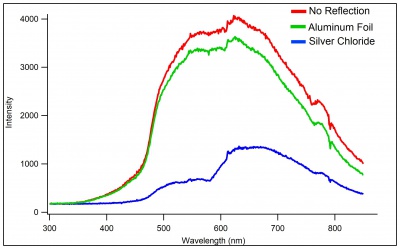Difference between revisions of "Reflection of Tungsten Bulb"
| Line 7: | Line 7: | ||
=Results= | =Results= | ||
[[File:Light_Experiment.jpg|400px|thumb|left|Figure 1: The intensity and wavelengths of a tungsten bulb being reflected off of nothing, aluminum foil, and silver chloride. ]] | [[File:Light_Experiment.jpg|400px|thumb|left|Figure 1: The intensity and wavelengths of a tungsten bulb being reflected off of nothing, aluminum foil, and silver chloride. ]] | ||
| + | |||
| + | It was shown that the aluminum foil reflected all of the light that the tungsten bulb put out as can be seen from the graph, there was no significant change from the diode being directly onto the tungsten bulb in relative to it reflecting off of the aluminum foil. However, the silver chloride showed a difference in the spectrum from | ||
Revision as of 21:13, 31 January 2019
Introduction
Light reflects off of surfaces differently depending on the surface. It is known that different metals reflect light at different wavelengths and intensity, but wanting to know how tungsten light reflects off of two different surfaces was tested. These being Aluminum foil and Silver Chloride. Thus the metals that are being tested are Aluminum and Silver.
Experiment
Two different types of metals were used to test the reflecting and intensity of light from a tungsten bulb. These metals were aluminum and silver. This was experimented against a control of there being no reflection (the light was emitted directly onto the probe). To test these a photodiode array was used and the data was then processed through Spectra Suite and Igor.
Results
It was shown that the aluminum foil reflected all of the light that the tungsten bulb put out as can be seen from the graph, there was no significant change from the diode being directly onto the tungsten bulb in relative to it reflecting off of the aluminum foil. However, the silver chloride showed a difference in the spectrum from
